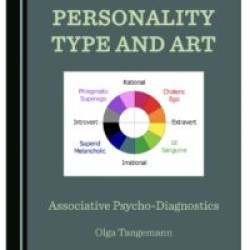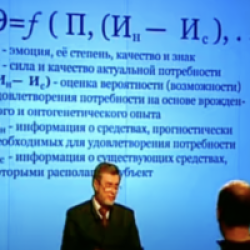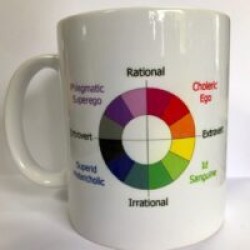Tangemann O. B. Types of Cognition and Logic from socionics viewpoint // Psychology and Socionics of interpersonal relations. –2012. – 11. – C. 34-36
The article describes new criteria for distinguishing between various personality types based upon one’s predisposition toward either absolute or relative cognition (absolutists and relativists). These juxtaposed ways of thinking constitute telltale typological characteristics and are correlated with the aspects of extraverted and introverted logic. Any of the 16 types may exhibit either an absolute or a relative cognitive pattern, which allows the sorter to determine the version (extra- or intro-) of the subject in the mental compartment of his psychological structure (Model A, the Butterfly Model).
Key words: absolute cognition, relative condition, extroverted logic, introverted logic, conscience, type, personality, socionics
If I may attract the reader’s attention to the new criteria of differentiation between the aspects of introverted and extroverted logic. Be advised, however, that the newly deduced formula serves only as a mere clarification of the definitions pertaining to the aspects in question in socionics theory and did not by chance, but rather is a direct result of observations and a series of spontaneous conversations with various types of people. The new concept induces contemplations about the legitimacy of contriving correlations between an aspect of logic and attributes, such as concreteness – abstractness, deduction – induction, discretion – continuity, etc.
Extroverted logicians and all those, who have a function of extroverted logic (Te) within Model A’s mental circle, are distinguished by their predisposition to absolutization – the practice of spotlighting an object (or an event) and ignoring its interactions with the other objects (i.e. the background), that are, in the understanding of the subject, unnecessary and trivial. The fact that these people are trying to increase the distance between the object and the background or to draw a clear-cut frontier separating the two in their judgments, is hardly surprising. It is the degree of the object’s expression and autonomy that especially matters to them, regardless of the backdrop.
Simultaneously, introverted logicians and all those, who have a function of introverted logic within Model A’s mental circle, reverse the aforementioned process: abandoning the efforts of increasing the distance between the object and the backdrop, they alter the background, describing the object in terms of its interactions with various relationship systems. That is how the growth of the object’s degree of relativity and its immersion into a complicated system of interactions and contingencies takes place. The people with a relative type of cognition perceive the object as merely one of the forms or as a part of the common system of relationships.
It can be said that both highlight the individual and peculiar properties of an object, although each does it in its own different way. For absolutists, it is the object by itself, deprived of whatever applicable connections, that rocks the boat, which is why the backdrop and the context often not only have very little significant meaning, but even hamper and impede the perception. Their language is often rife with text or significant words highlighted in bold or with the repetitive requirement of unambiguity, specificity, the presence of a single solution and a clear algorithm for resolving controversial and tangled issues. The relativity of event is not on the list of values.
Relativists, as opposed to absolutists, do not possess this habit and highlight the individual properties of an object through its interactions with other objects and events. To them it is more rational not to made the object stand out from background, but to expand the backdrop and the context, in order to determine the object’s position in the system of relationships, to classify it in one way or another. And there lies the thrust of relativists’ thinking.
Let us now review how well this concept fits into the associative theory of socionics and psyche energy types.
Types with Model A’s extroverted logic (Te) are also dynamists, when the 16 types are divvied up on the basis of the statics / dynamics trait. (1) Observations show that dynamists often prefer bright contrasts, the abrupt change from one tint to another, whether that pertains to music or colors. (2) In their language, the urge to assert an object against its background is encapsulated in the usage of a large font (capitals) for a word or a group of words, in the tendency to expose polarities and juxtapositions. Anything that bears negatively on the unequivocal tone is rejected, being dubbed “unnecessary.” The multitudes theory justifies the tendency in terms of the absolutists’ aspirations toward discreetness, singularity. Thus, it is arguable, that the dynamic types would have a tendency to absolutize events on the cognitive level, i.e. to separate one from another and to review each one autonomously.
The dynamic aspect of the psyche is determined by balancing out the two dynamic types of psychological energy in the individual’s psychological structure: the Superid and the Ego. TPE ego correlates very strongly with the tendency to absolutize events and to make oneself stand out from the pack of his fellow men. Ego is the awareness of the self as opposed to the all the other objects and multitudes. It would be impossible to conceive of oneself as a leader, able to halt the natural course of historical development and to subdue circumstances to free will, without the ability to highlight oneself as the highest authority. Ego is the man’s rational beginning. It is the part of personality structure that is in charge of decision-making (3). And even though every single one of the 16 types has an ego compartment within Model A’s framework, not all the types are said to have a dynamic profile or to belong to TPE Ego.
The absolutism tendency is common to Ego and Superid types, i.e. those types that have dynamic functions in their respective psyche models (Model A). Types with a static profile Superego-Id will exhibit a predisposition toward relativist cognitive patterns. In the context of psyche structure and Model A, superego is responsible for individual’s relationships with society, i.e. perception of an object or an event as a dependent, rather than autonomous, entity is postulated.
In order to render the typological distinctions more practical, let us draw a very simplified analogy. A person with an absolute cognition type wants to understand and explain the essence of the object. Suppose we are talking about various objects lying around on a table. This person will pick up an object and examine it in an isolated way. Such observation method simply renders the object’s features and deficiencies more apparent and comprehensible to her. She will want to conduct various manipulations with the object. All the other objects are superfluous and will only hinder the process.
A relativist, as opposed to an absolutist, will inspect and describe an object against the backdrop that comprises other objects, somewhat similar to or different from the main object. The best illustration of relativism is a “Spot the differences” game, as it develops relativist thinking and white (introverted) logic, in particular.
Having said that, people often alternate both methods when examining a particular event, but, nevertheless there is a predisposition toward one or the other type of thinking. These differences between cognition types can be legitimately correlated with aspects of extroverted and introverted logic. Absolutization and relativization are different forms of logical ways of thinking.
Examples of various types of cognition in our language exposed
These quotes owe their origins to the threads on the socionics forum posted by various participants. If I may now offer the reader to try and detect evidence for different types of thinking unaided, founding upon their respective descriptions in the article. If you are having trouble in determining the type of cognition, then the author of the article failed to impart her thoughts to you in a clear and coherent fashion.
1.“It is important to draw a distinction between ‘the negative’ and the ‘opposite.’ My construction of dichotomies is founded on the premise that all of the dichotomies (whether of an aspectual or, indeed, any other nature) must be STRICTLY OPPOSING. Only then can they be legitimately labeled as ‘dichotomies.’”
2.“Everything depends on the way in which the dichotomy is inherited by the offspring. For example, it could be an internal dichotomy, whereby the two opposing attributes collide in the same generation. Equally, it could be an external one, whereby the properties of one given attribute are juxtaposed across generations. I believe there is no utility in expounding further on all the possible combinations; they are quite simple. However, if neither of the possible forms of dichotomies materializes, then a reasonable suspicion can be entertained as to the lack of any connection between Jung and Ausra. But even then, be reminded that, this connection may not be direct, as socionics claims, but rather involve a common ancestor.”
3.“Once again, for the exceptionally sloooow thinkers:It will not arise HERE, within the visibility field.However, it may arise elsewhere, and then, after the passage of some time, this entire brothel will be swept away.For as long as you are present here, you are not learning anything about it. Guaranteed.”
4.“Both positive and negative values of the functions have been described by Mr. Gulenko in his article and reported in his first presentation at the “Round Table”. These values then go on top of the positivism – negativism trait, which is why it is a lot more rational to apply it accordingly, i.e. to correlate negative and positive values of the functions with positivism and negativism as one of the criteria for establishing the positivism-negativism trait. There is a correlation here, and it is conspicuous.”
5.“Let us pull up the Keeper’s description. What do we see?NOT A SINGLE submitted question being addressed in there. Not a single cross-reference to the description of the Seeker’s opportunities-oriented intuition.
Alas, socionics is rife with imperfections like this.”
6.“Pavel has a super-idea that division into black and white aspects (and functions) must be expressed as a juxtaposition of a sort. Why am I reluctant to retort? Actually, his concept does look more elegant. As a matter of fact, Aushra, to a certain extent, also attempted to define the functions in a similar fashion.”
7.“Once again I report that at the onset of my new hobby of socionics, I was bewildered by the fact that every classifier had his own socionics, his own methods, and his own typological models.”
8.“This notorious statement by Lenin still remains in active usage as of today. What we are concerned with is the fact that it has a direct bearing on the interactions of inclinations toward various activity types. And if it is just, then it follows that socializers harvest energy from managers. Now let us take a step further and look into the opposite groups of the socion.”
9.“No, the distinction palpably does not turn on details, but rests on the fact that the operation of division is applied to notions, substantially different in terms of their Division must exhaust the volume. Exhaustibility of volume is a necessary requirement in the operation of division. No exhaustibility– no division.”
10.“Contradictions are of zero significance, if we appreciate what numerical system we are on at this particular moment in time, when yielding various interpretations. What numerical system are our opponents using when offering a different interpretation? Contradictions will no longer matter only when everyone gets into the habit of appreciating the limits of an expert’s area of expertise. This is especially true in respect of those who show off by assigning a 99% probability to their claims. We all understand that this is arbitrary!”
11.“Once again, I am perplexed as to the cause of Irina’s highly unusual reaction. Especially in respect of some 4,000 people and a 25% mismatch that the Butterfly model yielded. Because this is a lot! It is the equivalent of the Butterfly model’s death. But no, still, Irina, the black logician, has only detected LIES in this number. This is probably because the number is too large and is heads and shoulders above the quantity of her protocols, which, by the way, attract my highest trust and confidence.
Absolutists: 1. ILI 3. SLI 5. LIE 7. ESE 9. ILI 11. LIE
Relativists: 2. ILE 4. ESI 6. IEE 8. LII 10. SLE
References:
Augustinavichute A. Socion. M.: “Black Squirrel” – 2008
Tangemann O.B. Associative Typology. “Socionics, mentology, and personality psychology” 2010, 4, pp. 65 – 70, 5 pp. 77-82
Tengemann O.B. Associative Butterfly Model. “Psychology and Socionics of interpersonal relations” 2009, 1, pp. 38-52









